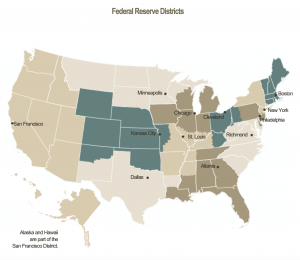Beef prices are projected to continue increasing as U.S. beef production declines with no signs of a cattle herd rebuild. Additionally, cheap beef may soon become further out of reach…
Federal Reserve: Observations on the Ag Economy- February 2021
On Wednesday, the Federal Reserve Board released its February 2021 Beige Book update, a summary of commentary on current economic conditions by Federal Reserve District. The report included several observations pertaining to the U.S. agricultural economy.

* Sixth District- Atlanta- “Agricultural conditions remained mixed. Abnormally dry conditions prevailed across much of the District. On a month-over-month basis, the February production forecast for Florida’s orange crop was up while the grapefruit production forecast was unchanged; both forecasts were below last year’s production. The USDA reported year- over-year prices paid to farmers in December were up for corn, cotton, rice, and soybeans but down for cattle, broilers, eggs, and milk. On a month-over-month basis, prices increased for corn, cotton, rice, soybeans, cattle, and broilers, but decreased for eggs and milk.”
* Seventh District- Chicago– “Contacts expected agricultural income to be solid in 2021, though down some from 2020’s strong results: Direct income from agricultural products could be higher in 2021, but federal government payments were expected to be lower.
Gov't payments forecast to decline, @ChicagoFed webinar. pic.twitter.com/QgJf3wtLGt
— Farm Policy (@FarmPolicy) February 24, 2021
“Corn, soybean, and wheat prices moved up during January and early February.
Higher crop revenues helped boost demand for farm equipment, and there were reports of low inventories of new equipment in some areas.
“Cattle and hog prices also moved up from the prior reporting period. Dairy prices were generally down, and producers faced uncertainty regarding demand from government food programs and schools. Looking ahead, recent adverse weather was expected to support prices, particularly for milk and cattle. Cold weather boosted costs for District farmers; more generally, contacts reported rising input costs for both crop farmers and livestock producers driven by higher fertilizer and feed prices. Farmland values continued to increase strongly.”
annual real change in farmland values, @ChicagoFed webinar. pic.twitter.com/mamco3Dr6a
— Farm Policy (@FarmPolicy) February 24, 2021
* Eighth District- St. Louis– “Agriculture conditions have improved moderately relative to the previous reporting period. The number of acres of winter wheat planted this season throughout the District increased sharply relative to the previous year, although acres planted declined slightly in Kentucky. Despite pessimism in early 2020, farmers expressed optimism after a strong finish in 2020, with prices and sales up well above what was expected.”
* Ninth District- Minneapolis– “District agricultural conditions improved moderately since the previous report, due to continued rallies in commodity prices and to government support programs. Respondents to the Minneapolis Fed’s fourth-quarter (January) survey of agricultural credit conditions reported increased farm income and capital spending compared with a year earlier, and the outlook for the next quarter was for continued growth in farm incomes.”
* Tenth District- Kansas City– “The Tenth District farm economy strengthened alongside a sharp rebound in farm income and agricultural credit conditions. In the most recent survey period, a majority of District contacts indicated that farm income was higher than a year ago for the first time since 2013, leading to increased loan repayments and slight increases in farm real estate values. Crop prices rose modestly since January and remained considerably higher than a year ago. Contacts located in regions more dependent on livestock revenues and exposed to severe drought, however, were less optimistic. Although cattle prices also increased modestly since January, they remained lower than a year ago, and higher crop prices could lead to higher feeding costs for livestock producers in the coming months.”
* Eleventh District- Dallas– “Precipitation over the reporting period eased drought conditions somewhat. Higher crop prices boosted optimism among farmers heading into spring planting, though there was some concern over higher input costs. The extent of the losses from the severe winter storms are not yet known, but will likely span the livestock and dairy sectors, produce, and wheat.”
* Twelfth District- San Francisco– “Agricultural activity expanded marginally across the District. Demand for wheat, fruits, and nuts increased among both domestic and international consumers. Most growers benefitted from a depreciating dollar, although a few noted the ongoing negative effects of international trade restrictions on U.S. exports. Several contacts in the Pacific Northwest and California mentioned that COVID- related labor and supply chain disruptions continued to put upward pressure on costs and to reduce inventories in some cases.”





